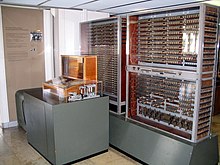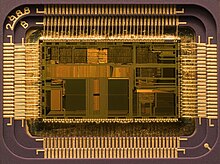History of computing
Main article: History of computing hardware
The first use of the word "computer" was recorded in 1613, referring
to a person who carried out calculations, or computations, and the word
continued with the same meaning until the middle of the 20th century.
From the end of the 19th century the word began to take on its more
familiar meaning, a machine that carries out computations.
Limited-function early computers
The history of the modern computer begins with two separate
technologies, automated calculation and programmability, but no single
device can be identified as the earliest computer, partly because of the
inconsistent application of that term. A few devices are worth
mentioning though, like some mechanical aids to computing, which were
very successful and survived for centuries until the advent of the electronic calculator, like the Sumerian abacus, designed around 2500 BC of which a descendant won a speed competition against a modern desk calculating machine in Japan in 1946, the slide rules, invented in the 1620s, which were carried on five Apollo space missions, including to the moon and arguably the astrolabe and the Antikythera mechanism, an ancient astronomical computer built by the Greeks around 80 BC. The Greek mathematician Hero of Alexandria
(c. 10–70 AD) built a mechanical theater which performed a play lasting
10 minutes and was operated by a complex system of ropes and drums that
might be considered to be a means of deciding which parts of the
mechanism performed which actions and when.This is the essence of programmability.
Around the end of the 10th century, the French monk Gerbert d'Aurillac brought back from Spain the drawings of a machine invented by the Moors that answered either Yes or No to the questions it was asked. Again in the 13th century, the monks Albertus Magnus and Roger Bacon built talking androids without any further development (Albertus Magnus complained that he had wasted forty years of his life when Thomas Aquinas, terrified by his machine, destroyed it).
In 1642, the Renaissance saw the invention of the mechanical calculator, a device that could perform all four arithmetic operations without relying on human intelligence.
The mechanical calculator was at the root of the development of
computers in two separate ways. Initially, it was in trying to develop
more powerful and more flexible calculators that the computer was first theorized by Charles Babbage and then developed. Secondly, development of a low-cost electronic calculator, successor to the mechanical calculator, resulted in the development by Intel of the first commercially available microprocessor integrated circuit.
First general-purpose computers
In 1801, Joseph Marie Jacquard made an improvement to the textile loom by introducing a series of punched paper cards
as a template which allowed his loom to weave intricate patterns
automatically. The resulting Jacquard loom was an important step in the
development of computers because the use of punched cards to define
woven patterns can be viewed as an early, albeit limited, form of
programmability.
The Most Famous Image in the Early History of Computing
This portrait of Jacquard was woven in silk on a Jacquard loom and
required 24,000 punched cards to create (1839). It was only produced to
order. Charles Babbage owned one of these portraits ; it inspired him in using perforated cards in his analytical engine. The Zuse Z3, 1941, considered the world's first working programmable, fully automatic computing machine.
It was the fusion of automatic calculation with programmability that produced the first recognizable computers. In 1837, Charles Babbage was the first to conceptualize and design a fully programmable mechanical computer, his analytical engine. Limited finances and Babbage's inability to resist tinkering with the design meant that the device was never completed—nevertheless his son, Henry Babbage, completed a simplified version of the analytical engine's computing unit (the mill) in 1888. He gave a successful demonstration of its use in computing tables in 1906. This machine was given to the Science museum in South Kensington in 1910.
In the late 1880s, Herman Hollerith
invented the recording of data on a machine-readable medium. Earlier
uses of machine-readable media had been for control, not data. "After
some initial trials with paper tape, he settled on punched cards ..." To process these punched cards he invented the tabulator, and the keypunch
machines. These three inventions were the foundation of the modern
information processing industry. Large-scale automated data processing
of punched cards was performed for the 1890 United States Census by Hollerith's company, which later became the core of IBM.
By the end of the 19th century a number of ideas and technologies, that
would later prove useful in the realization of practical computers, had
begun to appear: Boolean algebra, the vacuum tube (thermionic valve), punched cards and tape, and the teleprinter.
During the first half of the 20th century, many scientific computing needs were met by increasingly sophisticated analog computers, which used a direct mechanical or electrical model of the problem as a basis for computation. However, these were not programmable and generally lacked the versatility and accuracy of modern digital computers.
Alan Turing is widely regarded as the father of modern computer science. In 1936 Turing provided an influential formalisation of the concept of the algorithm and computation with the Turing machine, providing a blueprint for the electronic digital computer. Of his role in the creation of the modern computer, Time magazine in naming Turing one of the 100 most influential
people of the 20th century, states: "The fact remains that everyone who
taps at a keyboard, opening a spreadsheet or a word-processing program,
is working on an incarnation of a Turing machine".
The ENIAC, which became operational in 1946, is considered to be the first general-purpose electronic computer.
The Atanasoff–Berry Computer (ABC) was the world's first electronic digital computer, albeit not programmable. Atanasoff is considered to be one of the fathers of the computer. Conceived in 1937 by Iowa State College physics professor John Atanasoff, and built with the assistance of graduate student Clifford Berry,
the machine was not programmable, being designed only to solve systems
of linear equations. The computer did employ parallel computation. A 1973 court ruling in a patent dispute found that the patent for the 1946 ENIAC computer derived from the Atanasoff–Berry Computer.
The first program-controlled computer was invented by Konrad Zuse, who built the Z3, an electromechanical computing machine, in 1941.The first programmable electronic computer was the Colossus, built in 1943 by Tommy Flowers.
George Stibitz
is internationally recognized as a father of the modern digital
computer. While working at Bell Labs in November 1937, Stibitz invented
and built a relay-based calculator he dubbed the "Model K" (for "kitchen
table", on which he had assembled it), which was the first to use binary circuits to perform an arithmetic operation. Later models added greater sophistication including complex arithmetic and programmability.
A succession of steadily more powerful and flexible computing
devices were constructed in the 1930s and 1940s, gradually adding the
key features that are seen in modern computers. The use of digital
electronics (largely invented by Claude Shannon
in 1937) and more flexible programmability were vitally important
steps, but defining one point along this road as "the first digital
electronic computer" is difficult.Shannon 1940 Notable achievements include:
- Konrad Zuse's electromechanical "Z machines". The Z3 (1941) was the first working machine featuring binary arithmetic, including floating point arithmetic and a measure of programmability. In 1998 the Z3 was proved to be Turing complete, therefore being the world's first operational computer.
- The non-programmable Atanasoff–Berry Computer (commenced in 1937, completed in 1941) which used vacuum tube based computation, binary numbers, and regenerative capacitor memory. The use of regenerative memory allowed it to be much more compact than its peers (being approximately the size of a large desk or workbench), since intermediate results could be stored and then fed back into the same set of computation elements.
- The secret British Colossus computers (1943), which had limited programmability but demonstrated that a device using thousands of tubes could be reasonably reliable and electronically reprogrammable. It was used for breaking German wartime codes.
- The Harvard Mark I (1944), a large-scale electromechanical computer with limited programmability.[30]
- The U.S. Army's Ballistic Research Laboratory ENIAC (1946), which used decimal arithmetic and is sometimes called the first general purpose electronic computer (since Konrad Zuse's Z3 of 1941 used electromagnets instead of electronics). Initially, however, ENIAC had an inflexible architecture which essentially required rewiring to change its programming.
Stored-program architecture
Several developers of ENIAC, recognizing its flaws, came up with a
far more flexible and elegant design, which came to be known as the
"stored-program architecture" or von Neumann architecture. This design was first formally described by John von Neumann in the paper First Draft of a Report on the EDVAC,
distributed in 1945. A number of projects to develop computers based on
the stored-program architecture commenced around this time, the first
of which was completed in 1948 at the University of Manchester in England, the Manchester Small-Scale Experimental Machine (SSEM or "Baby"). The Electronic Delay Storage Automatic Calculator
(EDSAC), completed a year after the SSEM at Cambridge University, was
the first practical, non-experimental implementation of the
stored-program design and was put to use immediately for research work
at the university. Shortly thereafter, the machine originally described
by von Neumann's paper—EDVAC—was completed but did not see full-time use for an additional two years.
Nearly all modern computers implement some form of the stored-program
architecture, making it the single trait by which the word "computer"
is now defined. While the technologies used in computers have changed
dramatically since the first electronic, general-purpose computers of
the 1940s, most still use the von Neumann architecture.
Beginning in the 1950s, Soviet scientists Sergei Sobolev and Nikolay Brusentsov conducted research on ternary computers, devices that operated on a base three numbering system of −1, 0, and 1 rather than the conventional binary numbering system upon which most computers are based. They designed the Setun, a functional ternary computer, at Moscow State University. The device was put into limited production in the Soviet Union, but supplanted by the more common binary architecture.
Semiconductors and microprocessors
Computers using vacuum tubes as their electronic elements were in use throughout the 1950s, but by the 1960s had been largely replaced by semiconductor transistor-based
machines, which were smaller, faster, cheaper to produce, required less
power, and were more reliable. The first transistorised computer was
demonstrated at the University of Manchester in 1953. In the 1970s, integrated circuit technology and the subsequent creation of microprocessors, such as the Intel 4004,
further decreased size and cost and further increased speed and
reliability of computers. By the late 1970s, many products such as video recorders contained dedicated computers called microcontrollers, and they started to appear as a replacement to mechanical controls in domestic appliances such as washing machines. The 1980s witnessed home computers
and the now ubiquitous personal computer. With the evolution of the
Internet, personal computers are becoming as common as the television
and the telephone in the household.
Modern smartphones
are fully programmable computers in their own right, and as of 2009 may
well be the most common form of such computers in existence




No comments:
Post a Comment